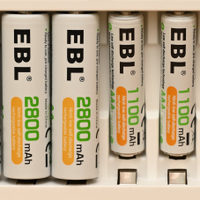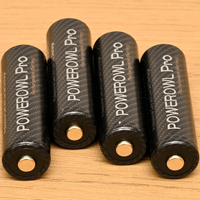Digital Camera World Verdict
These EBL 1.5V 3000mWh Li-ion Rechargeable AA Batteries score pretty highly for capacity. That’s good, as I like actually using my gadgets, in preference to endlessly changing and recharging the batteries that they run on. However, if your devices don’t need the full 1.5V output of Li-ion cells, you’re better off with cheaper 1.2V NiMH rechargeable batteries.
Pros
- +
Full 1.5V output per battery
- +
Long-lasting 3000mWh capacity
- +
Low self-discharge rate
- +
Claimed 1200+ recharge cycles
Cons
- -
Requires a specialist charger
- -
Sudden drop-off at end of discharge
- -
Up to 8-hour charging before first use
- -
Pricier than most NiMH batteries
Why you can trust Digital Camera World
I’ve tested and reviewed EBL AA 2800mAh & AAA 1100mAh NiMH batteries and was very impressed. I often use them in my camera flashguns, flashlights, gaming console controllers and other gadgets around the home. They’re certainly among the best AA rechargeable batteries and best AAA rechargeable batteries on the market. Compared with NiMH batteries, these EBL 1.5V 3000mWh Li-ion Rechargeable AA Batteries are pricier to buy and require a specialist charger (generally sold with the batteries themselves as a complete package) but have a voltage advantage.
EBL 1.5V 3000mWh Li-ion Rechargeable: What's changed?
If you’re of a certain age, you’ll remember the nightmare of NiCAD rechargeable batteries. Based on nickel-cadmium, they’re actually still available to buy but suffer from the dreaded ‘memory effect’. To get the best out of them, you need to discharge them completely before recharging them, rather than just topping up the charge whenever it’s convenient. NiMH (Nickel-Metal Hydride) rechargeable batteries addressed that pitfall but, traditionally, they still discharge all by themselves in just a few weeks, even when stored away and not in use.
More recent versions of NiMH rechargeable batteries follow in the pioneering footsteps of Panasonic Eneloop batteries, boasting a low self-discharge rate. It’s a big upside in that you can fully charge them, store them for months or even years, and they’ll still have most of their charge available when you actually come to use them. It’s a win-win situation, almost. The only real catch is that, unlike regular alkaline (non-rechargeable) batteries, NiMH as well as NiCAD batteries only deliver a nominal voltage of 1.2V instead of 1.5V. That can be a problem with some electronic devices that require a higher voltage to perform at their best, or even to work at all. These EBL Li-ion batteries aim to solve that problem as well.
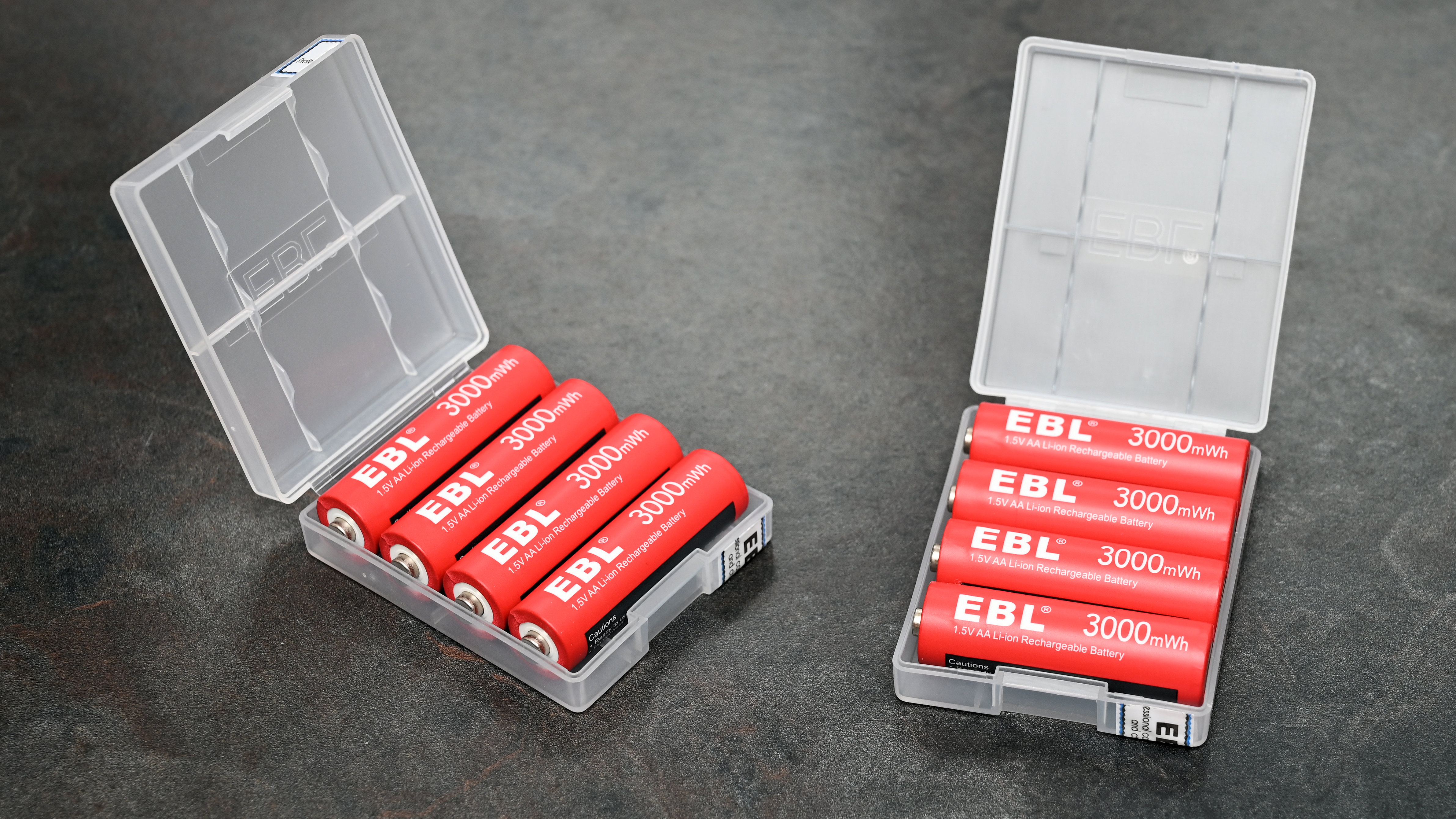
EBL 1.5V Li-ion Rechargeable Batteries: Specifications
| Type | Li-ion rechargeable |
| Size | AA |
| Voltage | 1.5V |
| Capacity | 3000mWh |
| Charge held | 85% after 3 years |
| Recharge up to | 1200 times |
EBL 1.5V Li-ion Rechargeable Batteries: Price & Availability
Battery for battery, EBL 1.5V 3000mWh Li-ion Rechargeable AA Batteries are about three times the price of EBL AA 2800mAh & AAA 1100mAh NiMH batteries. The Li-ion batteries need a specific charger so are often sold as a complete package that includes the charger as well, at a small extra cost. You can use this as a ‘starter pack’ and add extra packs of batteries on their own. As a rough guide, a pack of 8 AA batteries plus an 8-slot charger costs around $46/£40, or $26/$21 for 4 AA batteries and a 4-slot charger. 1200mWh AAA Li-Ion rechargeable batteries are also available in some world regions including the USA, but not currently in the UK.
EBL 1.5V Li-ion Rechargeable Batteries: Design & Handling
I picked up an 8-pack of AA batteries, complete with an 8-slot battery charger and was impressed by the high-quality look and feel of both items. An extra bonus is that the batteries come with robust storage cases, each accommodating up to 4 batteries. The kit comes with user manuals for both the batteries and the charger, which are also available online as PDFs.
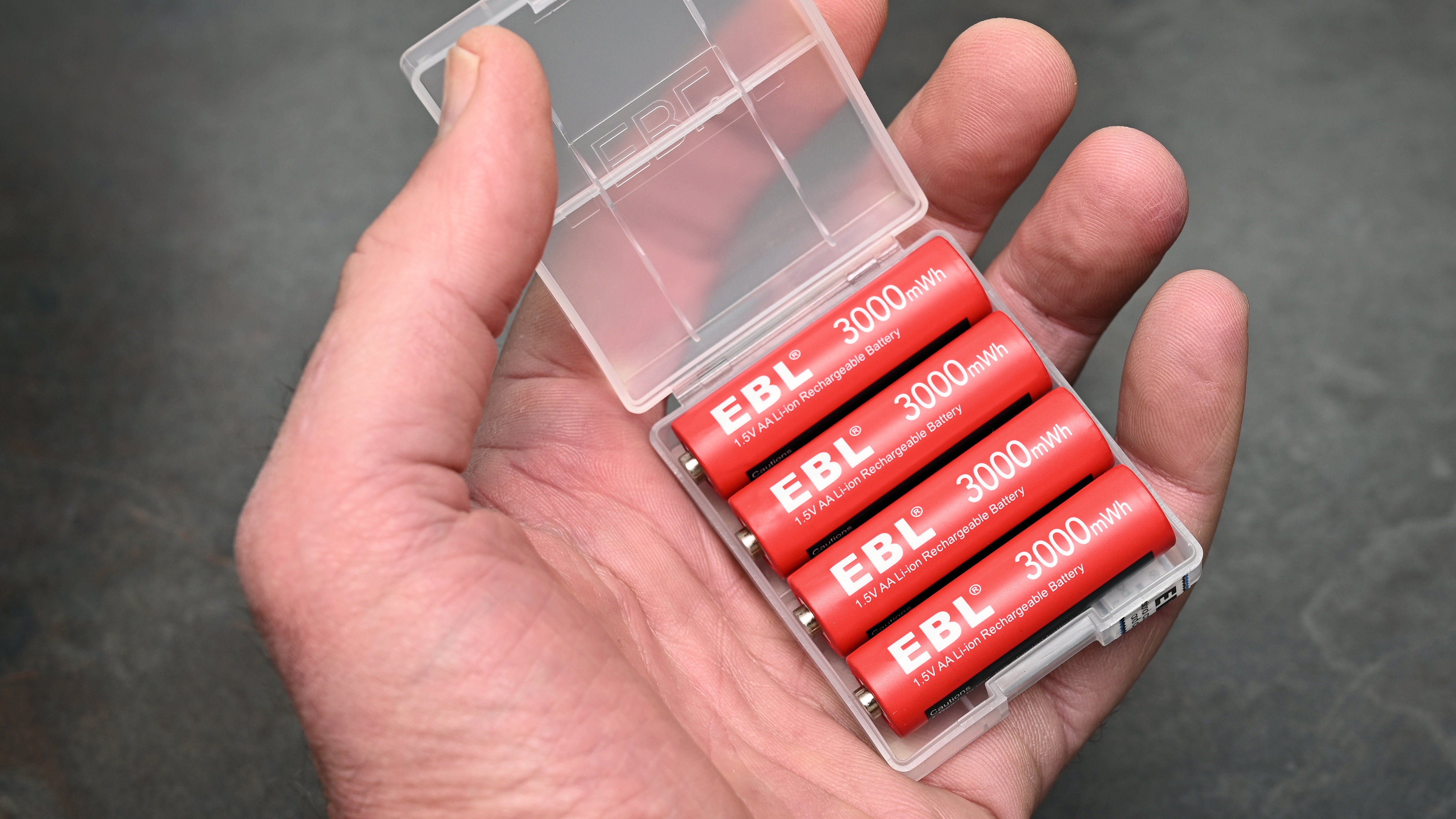
I like that most NiMH batteries nowadays are supplied pre-charged and ready for use. That’s certainly NOT the case with these Li-ion batteries, for which a full charge is recommended before first use. As I’ve mentioned, you can’t use a general NiMH battery charger, and need to use the specialist charger that’s designed for these Li-ion batteries. The charger connects via a USB-A to Micro-USB cable, supplied with the kit, rather than the more modern USB-C standard. No USB mains adapter is supplied, so you’ll have to use your own, or buy one, with a minimum of 1 amp output for the 4-slot charger and 2 amps output for the 8-slot charger.
An upside is that both chargers have an ‘individual channel’ design, so you can charge individual batteries or any multiple, rather than only charging them in pairs or groups of four. LED indicators for each channel flash red then green on power-up, then solid red while charging and green when that specific channel’s battery is fully charged. The chargers feature an ‘intelligent protection’ chip that guards against overcurrent, overvoltage, overcharging, overheating and short-circuit.
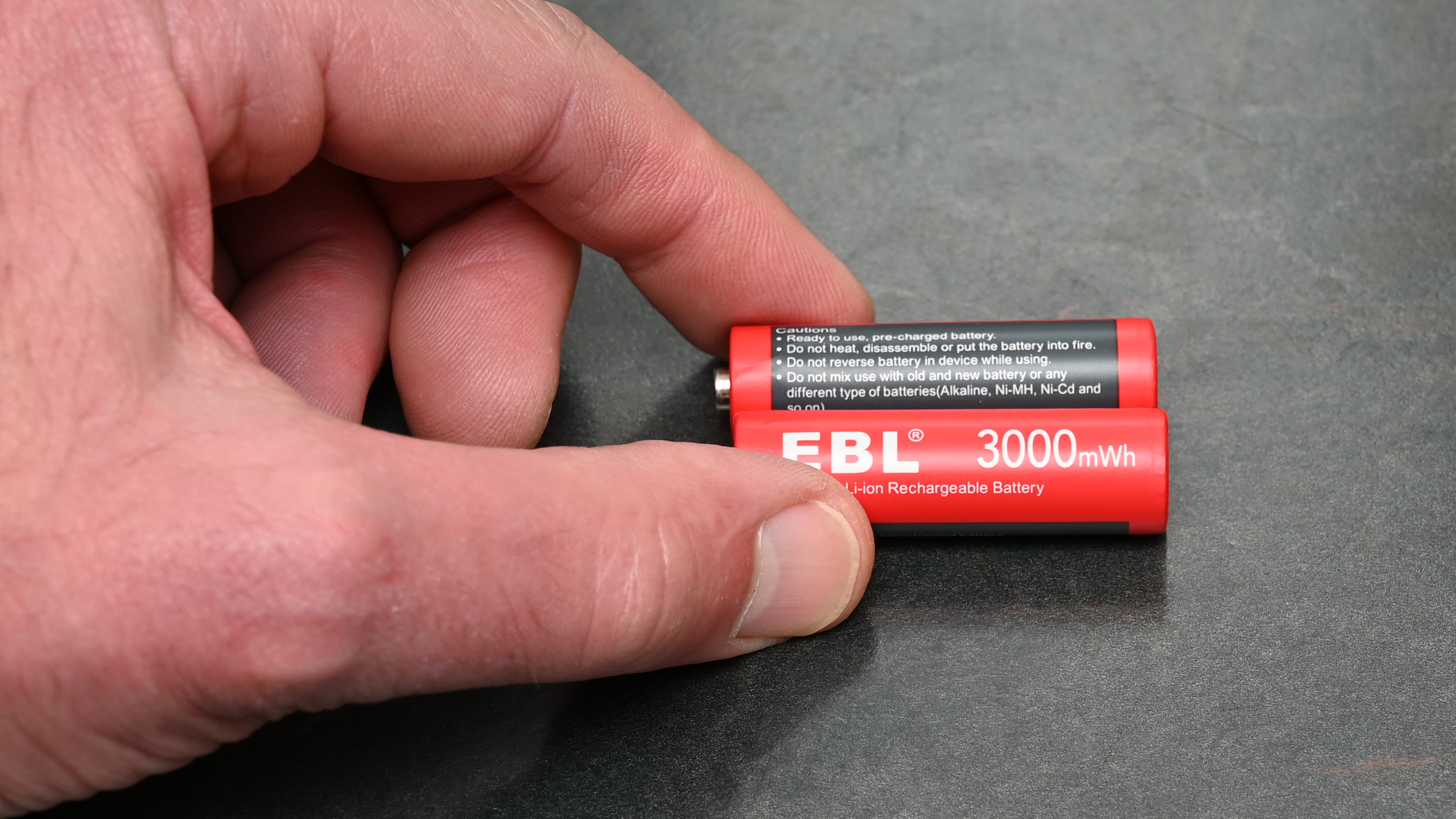
The AA rechargeable Li-ion batteries themselves have a capacity rating of 3000mWh, which can seem a little misleading. The capacity of most rechargeable batteries is quoted in mAh (milli-Amp hours), rather than mWh (milli-Watt hours). Do the math and a 1.5V 3000mWh battery equates to 2000mAh, lagging behind the 2800mAh NiMH rating of many of the highest-capacity NiMH batteries currently on the market, including those from EBL.
Both types of EBL battery have a very low self-discharge rate when stored and not in use. Safety features for the batteries include a built-in integrated circuit, which protects against overcharge, over discharge, overheating and short-circuit. The batteries also have a sealed construction to prevent leakage.
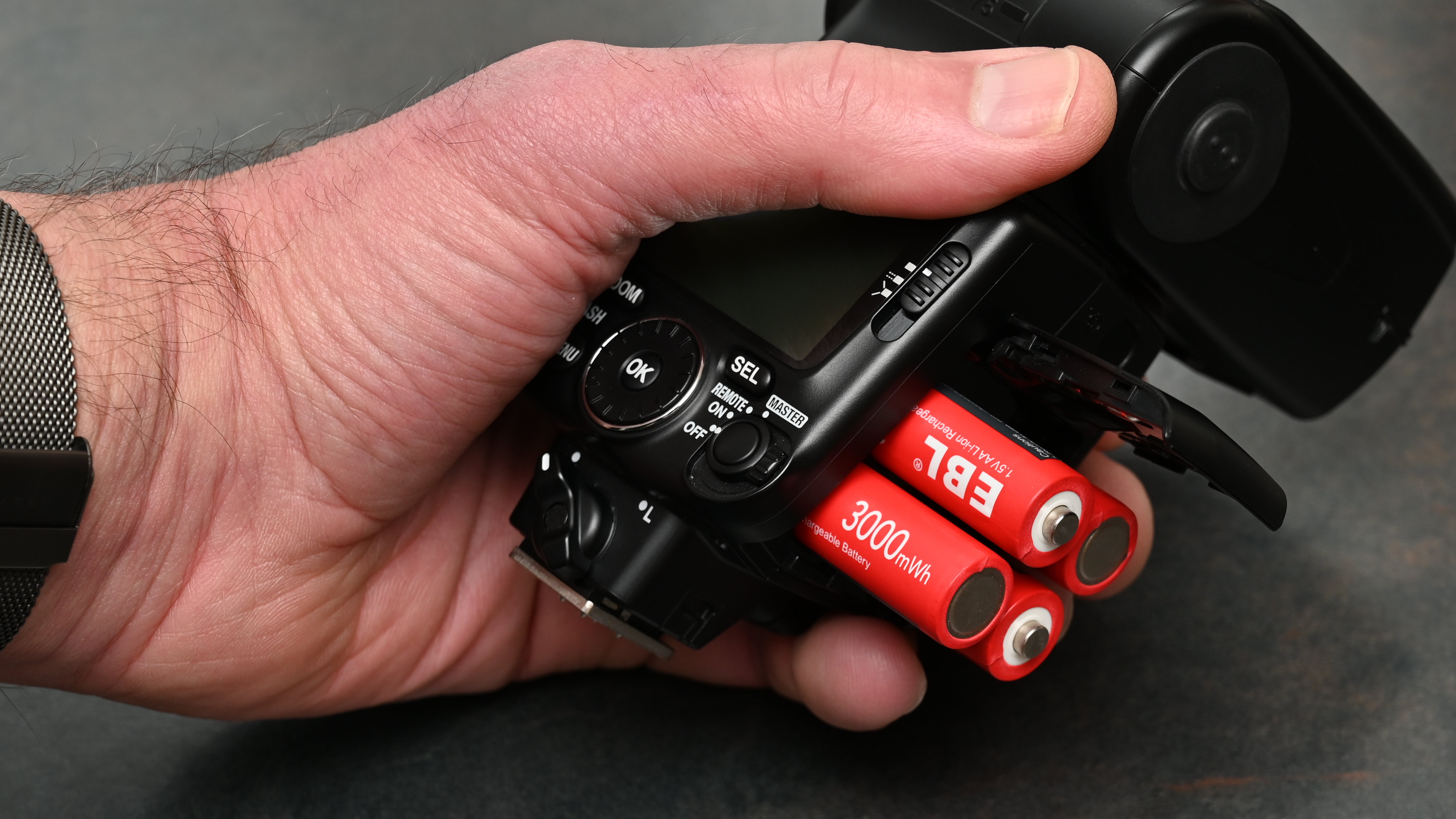
EBL 1.5V Li-ion Rechargeable Batteries: Performance
Some gadgets don’t play well with the 1.2V maximum output of NiMH batteries, compared with the 1.5V of conventional, non-rechargeable batteries. These Li-ion rechargeable batteries solve the problem by having a matching 1.5V output. A further plus point in terms of performance is that, like 1.2V NiMH batteries, they maintain their maximum voltage throughout pretty much the entire discharge cycle, whereas the voltage of 1.5V alkaline batteries starts dropping off as soon as you begin using them, and continues a steady decline until they’re flat. Use the Li-ion batteries in a flashlight, for example, and it’ll stay brighter for longer.
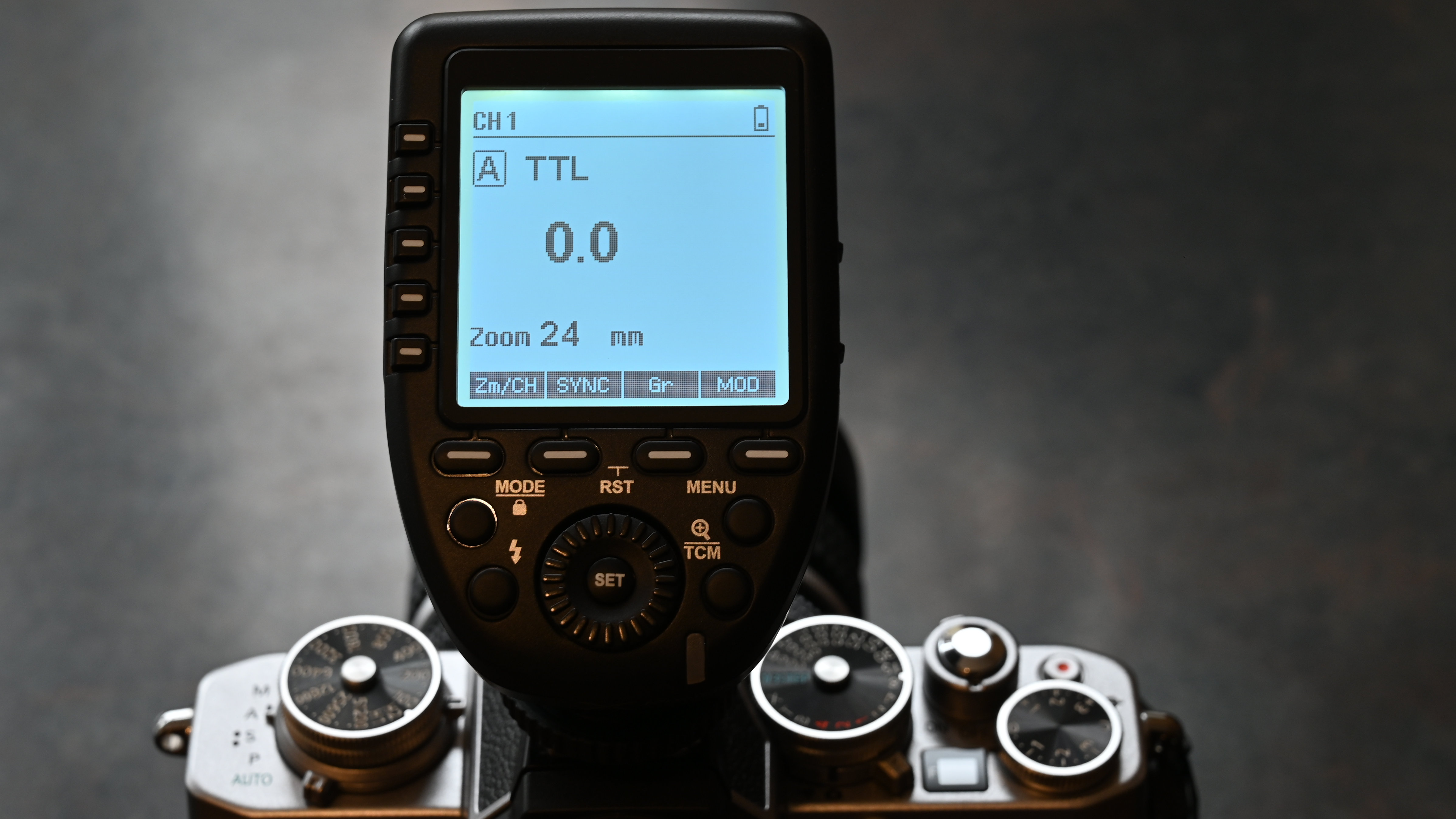
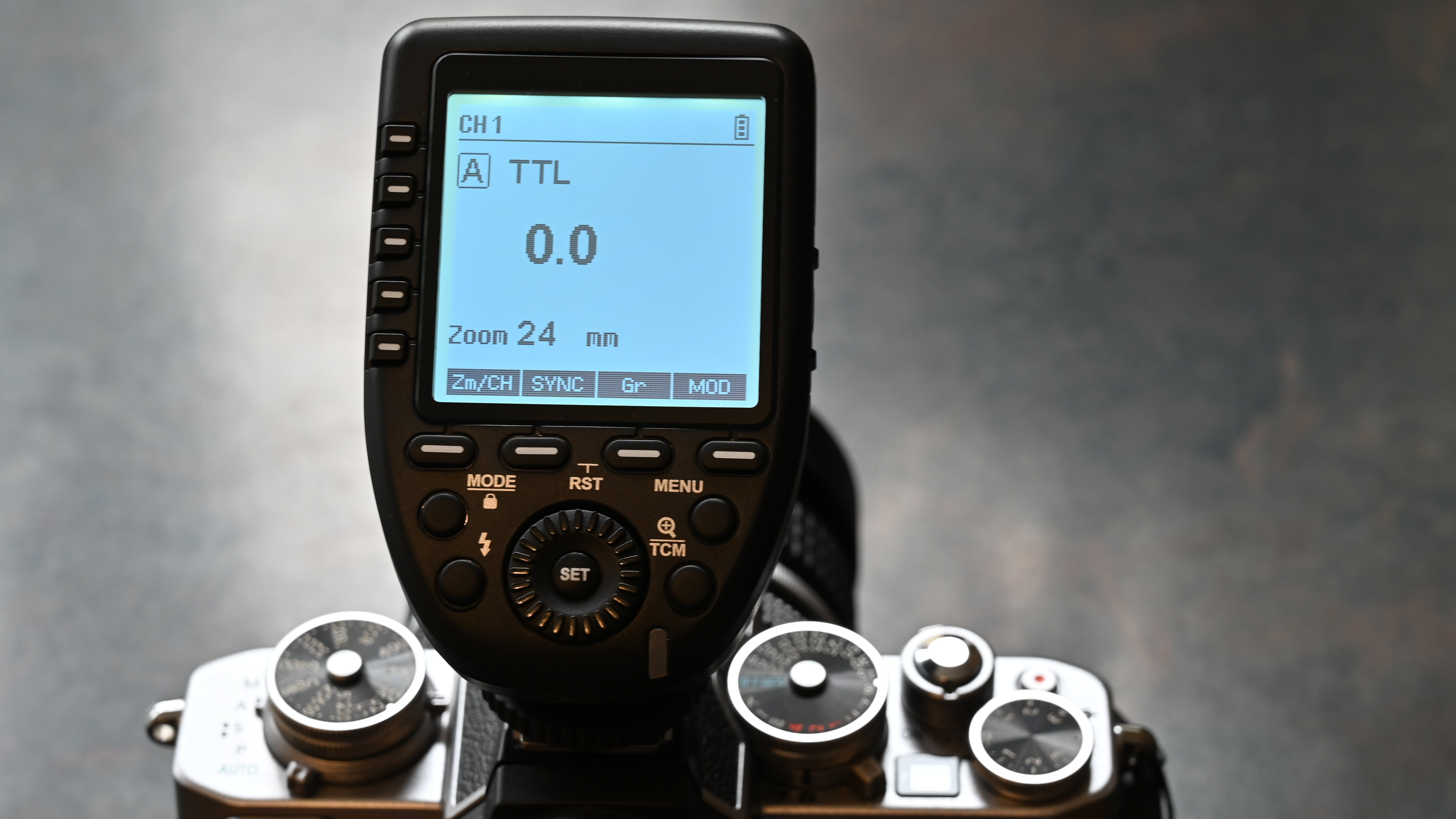
The flipside, for uses like flashlights, is that Li-ion batteries (as well as NiMH) go flat much more suddenly than alkaline batteries when they’re eventually exhausted, which can catch you out and literally leave you in the dark. Naturally, it’s always wise to have spare batteries in reserve and the low self-discharge rate helps with this. EBL states that after fully charging the batteries, 95% of the charge is retained after 6 months, 90% after a year, 85% after 2 years and 80% after 3 years. The company also advertises that the batteries have sufficient longevity to withstand 1200 or more charge/discharge cycles.
Straight out of the box, I found I had to charge the batteries in the supplied USB charger for between 4 and 8 hours before they were all at full capacity and ready for their first use. That can be frustrating compared with ‘ready to use’ NiMH batteries, if you’re not aware of the need for a lengthy wait. On the other hand, many of the latest high-capacity, low-self-discharge NiMH batteries (EBL included) are only shipped with 20% charge, claiming that this is due to safety issues. After draining the Li-ion batteries in use, subsequent recharging times were between 4 and 5 hours on average.
To test the performance of these AA batteries in a real-world context, I put a set of four into my trusty Nikon Speedlight SB-700 flashgun. For comparison, when I use premium alkaline batteries, I tend to get a recycling speed of about 3 seconds after a full-power flash with fresh batteries, dropping to 6.5 seconds after 50 flashes, 9 seconds after 75 flashes, and 13 seconds after 100 flashes. The upshot is that the performance starts deteriorating pretty quickly during the life of the batteries, and alkaline batteries generally run out of juice after about 115 full-power flashes.
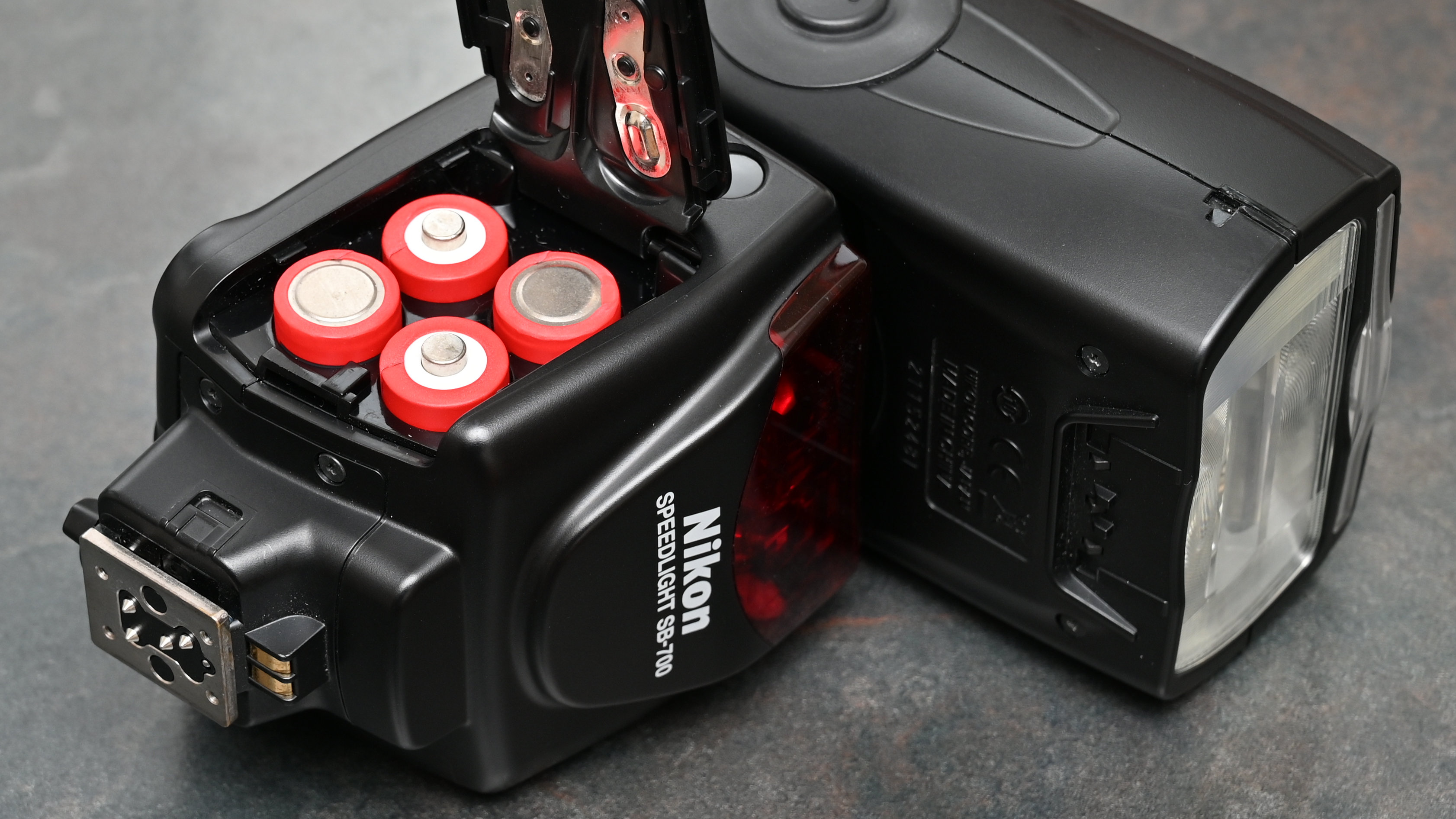
Using a fully charged set of four EBL Li-ion batteries, the recycling speed of the flashgun started off at a rather disappointing 7 seconds after a full-power flash. I found that this slowed to 8 seconds after 50 flashes and 9 seconds after 75 flashes, at this point matching the recycling speed on alkaline batteries. The recycling time remained at 9 seconds after 100 flashes, compared with 13 seconds for alkaline batteries. However, most NiMH batteries that I’ve tested in the same conditions gave recycling speeds of around 2 to 2.5 seconds over the same period. For photographic use when shooting with a flashgun, the longer wait using the EBL Li-ion batteries can result in missing important shots altogether.
Let’s take a look at staying power. With a fully charged set of four NiMH batteries rated at 2500mAh to 2800mAh, I usually get around 300 full-power flashes from my flashgun. That’s nearly three times as many as from a fresh set of alkaline batteries. The EBL Li-ion batteries were about half way in between, the recycling speed of my flashgun slowing from 9 seconds to 13 seconds after 200 flashes, and the batteries being exhausted after 207 flashes. Suffice it to say that with flashguns and most of my other battery-powered gadgets, I’ll be sticking with NiMH.
EBL 1.5V Li-ion Rechargeable Batteries: Verdict
As far as I’m concerned, EBL 1.5V 3000mWh Li-ion Rechargeable AA Batteries are a bit of a specialist item. Their main plus point is that they give a higher 1.5V output, compared with the 1.2V output of NiMH batteries. That can be a definite advantage for voltage-critical electronic devices. A further plus point for power-hungry gadgets is that, while they match the 1.5V of traditional alkaline (non-rechargeable) batteries, they retain their full voltage for virtually the whole of the discharge cycle rather than starting to drop off very quickly. As such, they work well for the likes of flashlights and radio-controlled models that run on electric motors. However, EBL states that, despite the 1.5V output, they’re not compatible with the Blink camera system. For most uses, I find that I get better performance for much less outlay with NiMH batteries, like EBL AA 2800mAh & AAA 1100mAh NiMH batteries. NiMH batteries also have the added convenience that I can recharge them in any generic NiMH battery charger.
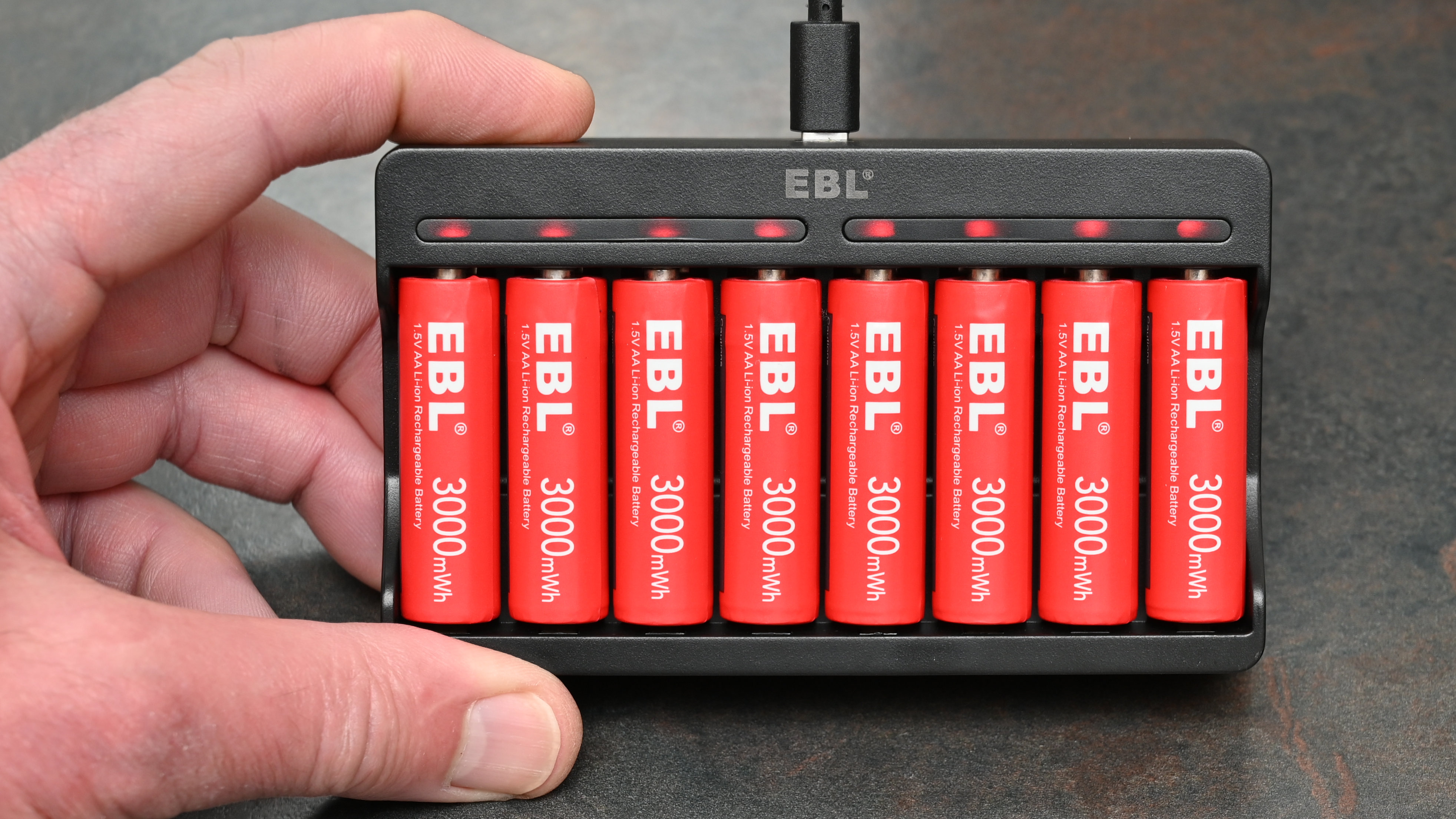
Should you buy the EBL 1.5V 3000mWh Li-ion Rechargeable Batteries?
✅ Buy this...
- 1.5V instead of 1.2V output
- Fairly high 3000mWh capacity
- Low self-discharge rate
🚫 Don't buy this...
- Needs a specialist charger
- Pricier than most Ni-MH batteries
- Incompatible with Blink cameras
Alternatives
Typical of latest-generation NiMH cells, EBL AA 2800mAh & AAA 1100mAh NiMH batteries have a low self-discharge rate, generous capacity and long life, with a claimed 1200 charge/discharge cycle rating. They cost around a third of the price of the EBL Li-ion batteries.
Going toe to toe with the EBL Ni-MH cells, the Powerowl Pro Goldtop AA 2800mAh & AAA 1100mAh batteries is a another cost-effective option that with the same headline attractions of high capacity, slow self-discharge and 1200 charge/discharge cycle rating.
Matthew Richards is a photographer and journalist who has spent years using and reviewing all manner of photo gear. He is Digital Camera World's principal lens reviewer – and has tested more primes and zooms than most people have had hot dinners!
His expertise with equipment doesn’t end there, though. He is also an encyclopedia when it comes to all manner of cameras, camera holsters and bags, flashguns, tripods and heads, printers, papers and inks, and just about anything imaging-related.
In an earlier life he was a broadcast engineer at the BBC, as well as a former editor of PC Guide.

